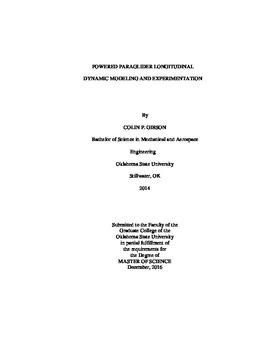| dc.description.abstract | Paragliders and similar controllable decelerators provide the benefits of a compact packable parachute with the improved glide performance and steering of a conventional wing, making them ideally suited for precise high offset payload recovery and airdrop missions. This advantage over uncontrollable conventional parachutes sparked interest from Oklahoma State University for implementation into its Atmospheric and Space Threshold Research Oklahoma (ASTRO) program, where payloads often descend into wooded areas. However, due to complications while building a powered paraglider to evaluate the concept, more research into its design parameters was deemed necessary. Focus shifted to an investigation of the effects of these parameters on the flight behavior of a powered system. A longitudinal dynamic model, based on Lagrange�s equation for adaptability when adding free-hanging masses, was developed to evaluate trim conditions and analyze system response. With the simulation, the effects of rigging angle, fuselage weight, center of gravity (cg), and apparent mass were calculated through step thrust input cases. Test flights evaluated the behavior of the paraglider, and the design was revised based on observations and analysis. Rigging angle sets the power-off glide slope as well as thrust capacity and input response damping. At more negative angles the glide slope is steeper, can handle more thrust, and damps quicker at a lower frequency. The fuselage weight, or loading, affects thrust capacity and power-off sink rate, with heavier gliders capable of larger thrust inputs but faster descent speed; however, the glide slope remains unchanged. As the cg position is place forward of the attachment point the incidence angle and thrust line will rotate downward, while the opposite occurs moving aft. For the test vehicle, a slightly forward position allowed for the greatest thrust input, and far forward reduced performance for equivalent thrust compared to far aft. Three test flights were performed. The paraglider displayed lateral oscillations due to fuselage-parafoil twisting and wing anhedral, despite its inherent keel effect. A wider parafoil mounting configuration provides increased twist resistance, which can otherwise cause sideslips and dihedral induced rolling, and adjusted rigging reduced wing arc. | |
